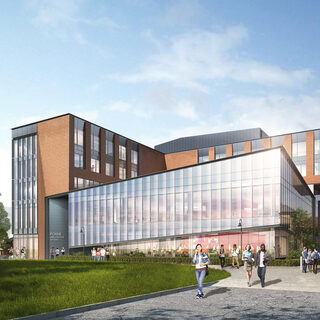Tradeline's industry reports are a must-read resource for those involved in facilities planning and management. Reports include management case studies, current and in-depth project profiles, and editorials on the latest facilities management issues.
Latest Reports
Purdue University Combines Classroom and Library Space to Promote Active Learning
Purdue University’s new 178,000-sf Wilmeth Active Learning Center (WALC) contains seven different types of classrooms that are so integrated into the Library of Engineering and Science that “at times, you almost can’t tell the difference between them,” says Nanette Andersson, director of library facilities. The design was borne of years of study into the effectiveness of active learning and the kinds of spaces that best support it. The result is a facility that is utilized nearly 24 hours a day.
Caltech’s New CAST Facility Simulates Testing Environments for Drones, Robots, and Satellites
To support its cutting-edge research in self-operated machines, the Center for Autonomous Systems and Technologies (CAST) at California Institute of Technology (Caltech) is equipped with several groundbreaking capabilities that set it apart from other engineering research facilities. At the top of the list are a drone testing arena capable of mimicking a full gamut of real-world weather conditions, and a zero-gravity-simulating space lab whose epoxy resin floor has been ground and polished to a final flatness of 0.003 of an inch. Three CAST components—the aerodrome, assembly lab, and the Space Robotics Controls Laboratory (SRCL)—are located in the 1940s-era Kármán building, originally constructed for wartime hydrodynamics research. Working with CO Architects and Matt Construction, Pasadena-based Caltech renovated the bunker-like building to create new types of spaces for cross-campus collaborations in the expanding field of autonomous drones, robots, and satellites, with a focus on practical applications in science, industry, and medicine.
Campus Crossroads
The new Campus Crossroads at the University of Notre Dame is the largest construction project in the school’s 175-year history. The project, which was four years in the making, consists of three new adjacent buildings anchored to the south, east, and west sides of the iconic 87-year-old stadium. The overarching goal was to integrate academic and student life into the game day experience at a facility that previously had been used for only eight days a year—for football games and commencement. The addition of 800,000 sf of new facilities transformed it into a year-round center of athletics, academics, and student life, with classroom, research, fitness, digital media, performance, meeting, event, and hospitality space.
WPI’s New Innovation Hub: Active Learning, Maker/Innovation Space, Entrepreneurship, and Residence Hall in One Building
The Foisie Innovation Studio & Messenger Residence Hall at the Worcester Polytechnic Institute (WPI) in Massachusetts supports a project-based curriculum and inspires new generations of students by merging three facility types in one building: interdepartmental maker/innovation space, high-tech active learning classrooms, and a 140-bed residence hall. The $50-million building, slated for completion in Augustn 2018, is designed for use by students from all academic disciplines. It offers a multidisciplinary environment to facilitate hands-on learning; collaboration between faculty, students, and external partners; and opportunities for entrepreneurship and innovation.
Five Key Design Elements of Successful STEM Facilities
After nearly a decade of gathering data about what makes a STEM facility competitive and attractive to students and faculty, EYP Architecture & Engineering has distilled five features that are key to radically redesigning successful STEM facilities. Survey results obtained from more than 1,500 students and 330 faculty members at six universities reveal the characteristics in a facility’s design that help make the institution more competitive, enhance the effectiveness of science and engineering teaching, advance faculty and student research, increase the students’ interest in the STEM disciplines, and promote welcoming places to learn, study, and interact.



